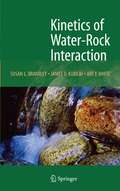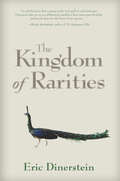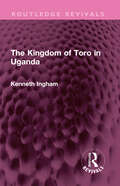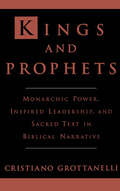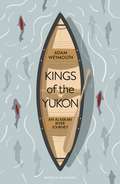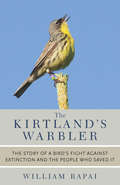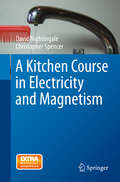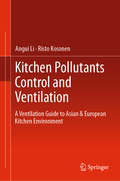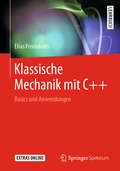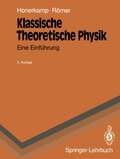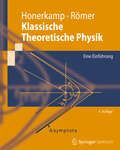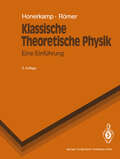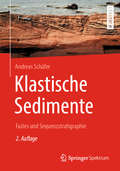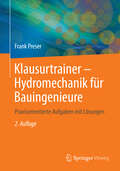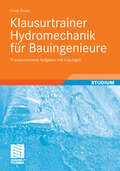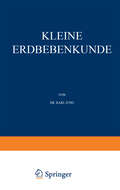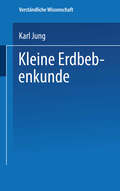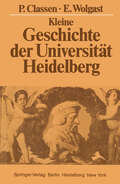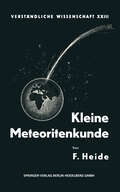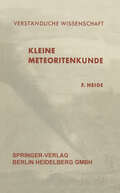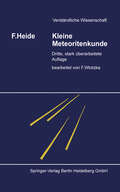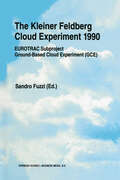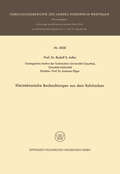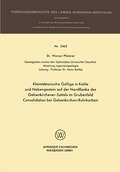- Table View
- List View
Kinetics of Water-Rock Interaction
by Susan Brantley James Kubicki Art WhiteGeochemical kinetics as a topic is now of importance to a wide range of geochemists in academia, industry, and government, and all geochemists need a rudimentary knowledge of the field. This book summarizes the fundamentals of geochemical kinetics with examples drawn especially from mineral dissolution and precipitation. It also encompasses discussion of high temperature processes and global geochemical cycle modeling. Analysis of textures of rocks, sediments, and mineral surfaces are incorporated throughout and provide a sub-theme of the book.
The Kingdom of Rarities
by Eric DinersteinThe Kingdom of Rarities presents a new context for understanding rarity and its implications both for our understanding of how the natural world works, and for what it can teach us about protecting biodiversity during a time of large-scale environmental change. Using cutting-edge science from remote outposts around the world, award-winning author Eric Dinerstein animates the key questions that scientists are asking themselves about why some species are so abundant and others not. What are the rarest species and why are they most likely to be found in certain types of environments? Which species have always been rare, and which have only recently been made rare? Which should we seek to protect most?Throughout, Dinerstein explores rarity as a central principle within conservation biology, advancing both our understanding of the natural world and inspiring the creation of new tools and technologies that can help us add to our knowledge and design more effective conservation strategies. He focuses on real-time threats to biodiversity, from climate change to habitat fragmentation, and draws on his long and distinguished scientific career to illuminate the concept of rarity for readers across the spectrum of scientific knowledge.
The Kingdom of Toro in Uganda (Routledge Revivals)
by Kenneth InghamFirst published in 1975, The Kingdom of Toro in Uganda describes the foundation of the Toro kingdom in the nineteenth century by the rebel prince Kaboyo, and investigates how Kasagama, Kaboyo’s grandson, was able to recreate, with little local support, a kingdom far more extensive than Kaboyo had ever envisaged. His personal authority was established by his insistence that its root were traditional, thus satisfying the requirements of ‘indirect rules’ at a time when this ill-defined concept served both as the shibboleth and the escape clause for an overstretched British colonial administration. Although Kasagama’s son, Rukidi, was able to combine authority with personal popularity and to take advantage of colonial innovations without losing control of his kingdom, the ending of colonial rule brought an end to Toro as he knew it. In an independent Uganda the particularism stressed by Toro’s rulers could not survive. This book will be of interest to students of history, colonialism, African studies and ethnic studies.
The Kingdom of Toro in Uganda (Routledge Revivals)
by Kenneth InghamFirst published in 1975, The Kingdom of Toro in Uganda describes the foundation of the Toro kingdom in the nineteenth century by the rebel prince Kaboyo, and investigates how Kasagama, Kaboyo’s grandson, was able to recreate, with little local support, a kingdom far more extensive than Kaboyo had ever envisaged. His personal authority was established by his insistence that its root were traditional, thus satisfying the requirements of ‘indirect rules’ at a time when this ill-defined concept served both as the shibboleth and the escape clause for an overstretched British colonial administration. Although Kasagama’s son, Rukidi, was able to combine authority with personal popularity and to take advantage of colonial innovations without losing control of his kingdom, the ending of colonial rule brought an end to Toro as he knew it. In an independent Uganda the particularism stressed by Toro’s rulers could not survive. This book will be of interest to students of history, colonialism, African studies and ethnic studies.
Kings And Prophets: Monarchic Power, Inspired Leadership, And Sacred Text In Biblical Narrative
by Cristiano GrottanelliThis collection of essays examines the respective religious and social functions of kings and prophets as they are presented in the biblical narratives. Biblical kingship is easily shown to be a specific instance of an ancient and widespread institution--sacred monarchy--that was the pivot of most state organizations throughout antiquity; prophetic authority is described as a typical institution of ancient Hebrew society. The difference between monarchy and prophecy is radical, because the former implies a hereditary power and is upheld by its subjects who feed their kings with taxes, while the latter derives its authority from allegedly direct divine inspiration, and though it is also economically dependent it is not explicitly presented as being based upon systematic exploitation. Cristiano Grottanelli interprets the rise of prophecy as a consequence of a crisis of monarchical structures at the beginning of the Iron Age, and connects it to similar phenomena attested in ancient Greek texts derived from a similar crisis. Though monarchy finally won the day in the Ancient Mediterranean in a new imperial form, the new literatures in Greek and Hebrew consonantic and alphabetic scripts shaped nonmonarchic figures to which they attributed some of the functions previously pertaining to monarchy. These new literatures, produced by two cultures that were both highly literate and organized according to nonmonarchical principles, diverged radically in their development and final outcomes. In the Hebrew tradition, monolatry and an official canon of sacred writings were the final result; the prophetic principle was thus overcome by a new ideological construction, centered upon inspired scriptures rather than upon the impromptu performances of inspired persons. In using the prophetic principle against the monarchic, the canonical texts paradoxically shaped their own authority above that of living prophets.
Kings of the Yukon: An Alaskan River Journey
by Adam Weymouth'Enthralling' Luke Jennings, author of Blood Knots'Stirring and heartbreaking' David Owen, author of Where the Water GoesA captivating, lyrical account of an epic voyage by canoe down the Yukon River.The Yukon River is almost 2,000 miles long, flowing through Canada and Alaska to the Bering Sea. Setting out to explore one of the most ruggedly beautiful and remote regions of North America, Adam Weymouth journeyed by canoe on a four-month odyssey through this untrammelled wilderness, encountering the people who have lived there for generations. The Yukon's inhabitants have long depended on the king salmon who each year migrate the entire river to reach their spawning grounds. Now the salmon numbers have dwindled, and the encroachment of the modern world has changed the way of life on the Yukon, perhaps for ever.Weymouth's searing portraits of these people and landscapes offer an elegiac glimpse of a disappearing world. Kings of the Yukon is an extraordinary adventure, told by a powerful new voice.
The Kirtland's Warbler: The Story of a Bird's Fight Against Extinction and the People Who Saved It
by William RapaiThis book looks at the Kirtland’s warbler and wildlife conservation in a way that no other book has. It looks back on the history of this unique bird, examines the people and policies that kept the warbler from extinction, explores the cult of personality that surrounds it, and examines the challenges of the future—all through the eyes of the people who have acted so passionately on its behalf. The story of the Kirtland’s warbler is a story of complex relationships between the bird and its environment, the humans who interact with it, and the complex government policies that affect it. And now, just when it appears that the Kirtland’s warbler has recovered for good, a change in its status may send the warbler’s population into a downward spiral once again.
A Kitchen Course in Electricity and Magnetism
by David Nightingale Christopher SpencerElectricity is all around us: cars, telephones, computers, lights -- the modern world runs entirely on electrons. But what are electrons? How do they behave? How do we control them? This book will show you how to build a battery, detect static electricity and construct a basic current meter, all using common items from your kitchen. Along the way you'll learn about the meaning of "voltage" and "current", what makes an LED work and the difference between AC and DC. The last chapter uses transistors -- the basic building blocks of every computer -- for lots of interesting experiments. With plenty of colorful illustrations, historical stories and an easy, accessible style, "A Kitchen Course in Electricity and Magnetism" will be a great start for budding and amateur scientists who want to learn more about how the world works.
Kitchen Pollutants Control and Ventilation: A Ventilation Guide to Asian & European Kitchen Environment
by Angui Li Risto KosonenThis book has been written by two experts in ventilation and indoor air quality with vast experience in the field of kitchen ventilation in both Asia and Europe. The authors share their extensive knowledge of the subject and present the results of their research programs as well those of other researchers. Discussing advanced theories of and design approaches for kitchen ventilation, it is a useful reference resource for a wide range of readers, including HVAC researchers, designers and architects.
Klassische Mechanik mit C++: Basics und Anwendungen
by Elias PosoukidisDas vorliegende Buch gibt Studierenden der Physik und der Ingenieurwissenschaften einen pragmatischen und anwendungsorientierten Einstieg, Probleme der Physik mit C++ zu lösen. Zusammen mit der GNU Scientific Library, einer kostenlosen Bibliothek für numerische Algorithmen, zeigt der Autor, wie man mit wenigen Schritten Computerprogramme zur Lösung von typischen Aufgaben aus der klassischen Mechanik schreibt. Dabei geht er auch auf Aspekte wie die Weiterverarbeitung von Daten zur Darstellung als Tabellen und Diagramme ein.Das Buch beginnt mit einer Tour durch C++: Moderne Sprachelemente, die Standard Template Library und der Entwurf von Klassen spielen eine zentrale Rolle. Es folgt die Besprechung der GNU Scientific Library. Schritt für Schritt wird gezeigt, wie Routinen zur Lösung von linearen Gleichungssystemen, Nullstellensuche, numerischen Integration und Lösung von Differenzialgleichungen in eigenen Programmen eingesetzt werden können. Das Buch schließt mit ausführlichen Aufgaben zur theoretischen Mechanik: geradlinige Bewegungen mit und ohne Reibung und mechanische Schwingungen. Zahlreiche Beispiele und zusätzliche Übungsaufgaben helfen Leserinnen und Lesern dabei, das Gelernte anzuwenden und zu festigen. Alle Rechenschritte, Programmiertechniken und Quelltexte werden ausführlich erklärt, was einen schnellen Einstieg in die komplexe Thematik ermöglicht. Grundkenntnisse der Mechanik und von C++ werden vorausgesetzt. Die Quelltexte stehen zum Download bereit und können leicht in eigene Projekte integriert werden. Der AutorElias Posoukidis hat an der Ruhr-Universität Bochum Physik studiert. Er hat Bücher zur GUI-Programmierung geschrieben, hat als Entwickler und Software-Architekt gearbeitet und unterrichtet nun Physik an einem griechischen Lyzeum.
Klassische Theoretische Physik: Eine Einführung (Springer-Lehrbuch)
by Josef Honerkamp Hartmann RömerDieses Lehrbuch stellt eine grundlegende Einführung in die klassischen Gebiete der Theoretischen Physik dar. Der Gebrauch exakter Terminologie führt zu einem knappen, gut durchdachten Text, der mit durchgerechneten Beispielen und 39 Übungsaufgaben aufgelockert wird. Neben der Klassischen Mechanik und Elektrodynamik finden auch Thermodynamik, Strömungslehre und Statistische Mechanik ihren Raum. Dieses Buch macht den Studenten mit der ganzen Breite der klassischen Theoretischen Physik vertraut und bringt ihm auch Angewandte Aspekte nahe.
Klassische Theoretische Physik: Eine Einführung (Springer-Lehrbuch)
by Josef Honerkamp Hartmann RömerDas Lehrbuch bietet eine systematische Einführung in die Grundgebiete der klassischen theoretischen Physik. Um Lesern schon zu Beginn den Überblick zu erleichtern, haben die Autoren besonderen Wert auf eine klare Darstellung des begrifflichen Gerüsts gelegt. Gebiete wie statistische Mechanik, Thermodynamik, Aero- und Fluiddynamik sowie aktuelle Anwendungen werden in zusätzlichen Kapiteln vertieft. Der Band enthält zahlreiche durchgerechnete Beispiele und Übungsaufgaben, die Neuauflage wurde um Abschnitte zur speziellen Relativitätstheorie ergänzt.
Klassische Theoretische Physik: Eine Einführung (Springer-Lehrbuch)
by Josef Honerkamp Hartmann RömerKlastische Sedimente: Fazies und Sequenzstratigraphie
by Andreas SchäferKlastische Sedimente entstehen durch Verwitterung und Erosion von Gesteinen. In Faziesmodellen geordnet, dokumentieren sie die verschiedenen genetischen Bedingungen ihres Transports und ihrer Ablagerung. Diese werden hier anhand eigener Fallstudien und solcher aus der Literatur dargestellt und erklärt. Mit dem Arbeitskonzept der Sequenzstratigraphie werden Ablagerungsprozesse im Detail interpretiert, zeitlich fixiert und über große Entfernungen hinweg miteinander korreliert. Sie bereitet das ordnende Prinzip für die Analyse von Strukturen und Fazieskörpern in Sedimentbecken, und stellt ein hervorragendes Werkzeug für wissenschaftliche und vor allem angewandte Fragestellungen dar.Die zweite Auflage wurde aktualisiert, auf das gewachsene Arbeitsfeld der Sedimentgeologie angepasst und um regionale Beispiele ergänzt. Das moderne Layout wird durch die nunmehr farbigen Abbildungen unterstrichen. Wichtige Fachbegriffe werden sichtbar hervorgehoben.
Klausurtrainer - Hydromechanik für Bauingenieure: Praxisorientierte Aufgaben mit Lösungen
by Frank PreserDas Fachbuch mit Aufgaben im Klausurcharakter bietet eine kompakte Zusammenfassung klassischer Themen der Hydromechanik für Lehre und Praxis. Alle Übungsaufgaben prüfen, unterstützen und trainieren das Verständnis der Hydromechanik. Dabei ist der Lösungsansatz systematisiert dargestellt und mit theoretischen Hintergrundinformationen verständlich aufbereitet. Die zweite Auflage ist thematisch erweitert und enthält neue Aufgaben. Die angeführten Beispiele beziehen sich auf die alltägliche Arbeitspraxis von Bauingenieuren und Wasserbauer. Auf diese Weise bietet das Buch eine optimale Vorbereitung für Studium und Beruf.
Klausurtrainer Hydromechanik für Bauingenieure: Praxisorientierte Aufgaben mit Lösungen
by Frank PreserDas Fachbuch mit Aufgaben im Klausurcharakter ist eine Zusammenfassung klassischer Themen der Hydromechanik für Lehre und Praxis. Alle Übungsaufgaben prüfen, unterstützen und trainieren das Verständnis der Hydromechanik. Dabei ist der Lösungsansatz systematisiert und mit theoretischen Hintergrundinformationen verständlich dargestellt. Die Beispiele beziehen sich auf die tägliche Arbeitspraxis von Wasser- und Bauingenieuren.
Kleine Erdbebenkunde (Verständliche Wissenschaft #37 )
by Karl JungDieser Buchtitel ist Teil des Digitalisierungsprojekts Springer Book Archives mit Publikationen, die seit den Anfängen des Verlags von 1842 erschienen sind. Der Verlag stellt mit diesem Archiv Quellen für die historische wie auch die disziplingeschichtliche Forschung zur Verfügung, die jeweils im historischen Kontext betrachtet werden müssen. Dieser Titel erschien in der Zeit vor 1945 und wird daher in seiner zeittypischen politisch-ideologischen Ausrichtung vom Verlag nicht beworben.
Kleine Meteoritenkunde (Verständliche Wissenschaft #23 )
by Fritz HeideDieser Buchtitel ist Teil des Digitalisierungsprojekts Springer Book Archives mit Publikationen, die seit den Anfängen des Verlags von 1842 erschienen sind. Der Verlag stellt mit diesem Archiv Quellen für die historische wie auch die disziplingeschichtliche Forschung zur Verfügung, die jeweils im historischen Kontext betrachtet werden müssen. Dieser Titel erschien in der Zeit vor 1945 und wird daher in seiner zeittypischen politisch-ideologischen Ausrichtung vom Verlag nicht beworben.
Kleine Meteoritenkunde (Verständliche Wissenschaft #23)
by Fritz HeideWohl alle Leser dieses Büchleins haben schon eine Stern schnuppe gesehen. Am klaren Nachthimmel taucht plötzlich ein kleines Lichtpünktchen auf, nicht größer als seine feststehenden Sterngenossen, lautlos schießt es ein Stück des Himmelsgewölbes entlang und verschwindet ebenso plötzlich und ebenso still, wie es aufgetaucht war. "Ein Stern ist vom Himmel gefallen", sagen die Menschen, und als ein gutes Vorzeichen gilt es ihnen. Wer sich schnell genug von der Überraschung erholt und gleich einen Wunsch äußern kann, dem soll er in Erfüllung gehen. Noch eine andere Erscheinung am nächtlichen Himmel werden viele Leser schon gesehen haben. Nicht mehr ein Lichtpünktchen von Sternengröße, sondern eine große Kugel mit augenfälligen Leuchterscheinungen, strahlend in bläulichweißem oder rötlich gelbem Licht, durcheilte wiederum lautlos einen großen Teil des Himmelsgewölbes, verschwand hinter dem Horizont oder ver löschte plötzlich. Ein "Meteor" nennen die Fachleute diese Er scheinung. Von einer dritten Himmelserscheinung werden aber wohl nur wenige Leser Augenzeuge gewesen sein. Taghell wird plötzlich die Nacht erleuchtet. Ein großer Feuerball, mit einem langen, leuchtenden Schweif hinter sich, zieht daher, Zischen, Knattern und Donnern ertönt, und ein explosionsartiger Knall schließt die nur wenige Sekunden dauernde Erscheinung ab. So intensiv ist das Geschehen, daß es sich auch bei hellichtem Tage durchaus bemerklich macht. Die Menschen, die zufällig am Ende der Bahn stehen, sehen feste Körper aus der Luft herabfliegen, und wenn sie in den Löchern, die diese Körper in den Erdboden geschlagen haben, nachgraben, dann finden sie Brocken von steiniger oder metallischer Beschaffenheit.
The Kleiner Feldberg Cloud Experiment 1990: EUROTRAC Subproject Ground-Based Cloud Experiment (GCE)
by SandroFuzziThe eleven papers presented in this issue are intended to provide a comprehen sive description of the cloud systems studied during the Kleiner Feldberg experi ment. The first paper provides a general overview of the experiment and a summa ry of the main accomplishments. The following three papers then describe the cloud systems from the meteorological, microphysical and chemical perspectives. Another four papers address more specifically the issues of incorporation of aerosol particles and trace gases within cloud droplets. A synthesis of the Kleiner Feldberg cloud properties and a comparison with experimental data is then provided by a paper which models the airflow and cloud mycrophysics and chemistry for selected cloud episodes during the experiment. Deposition of trace substances via cloud interception with the vegetation is the subject of the next paper, which integrates experimental data in a deposition resistance model. A technical paper at the end of the issue reports on a newly developed holographic technique to measure cloud droplet size distribution, which was tested for the first time during this experiment. The collaborative nature of the work accomplished within GCE is emphasized by the large authorship of most papers presented in this issue. This should not be regarded with surprise, but rather as an indication of the interdisciplinary efforts of the GCE scientific community for the accomplishment of this study. SANDRO FUZZI Coordinator, EUROTRAC sub-project GCE Journal of Atmospheric Chemistry 19: 3-35, 1994. 3 © 1994 Kluwer Academic Publishers. The Kleiner Feldberg Cloud Experiment 1990.
